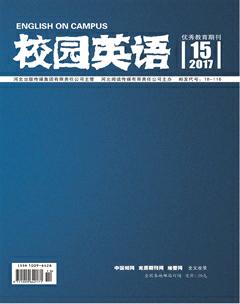Context and Translation
Wang+Jiajia++Zhang+Yonggang
【Abstract】Language is an indispensable part in our life. It is a tool for transmitting and a social phenomenon which used in certain environment. The relationship between translation and context are inseparable.
【Key words】context; translation; situational context; cultural context
1. The Definition of Context
As we all know, context plays an important role which refers to the status and condition when people talk to othersincluding time, place and situation. To a same word, it might be different if the word is said by different man in some occasions. Generally speaking. A single word or sentence has no specific meaning, only when it is used in a concrete context can express an accurate meaning.
2. Classification and Function
There are various opinions for classification. Widely speaking, it can be divided into macro and micro context; From the perspective of linguistics, it can be divided into linguistic context and illocutionary context; From the perspective of sociology, it can be divided into subjective context and objective context; From the angle of literature, the context can be divided into discourse, situational context and cultural language. There are six functions below, Absolute Function, Restrictive Function, Explanation Function, Derived Function, Filtering Function, Compensation Function.
3. Pay Attention to Original Context
Culture is the survival and development soil of language. The language rooted in different cultural soil has the culture of the society inevitably. Cultural context is the cultural and social background which a discourse involved. Original discourse is produced and propagated under the primitive society and cultural background, but its translation would propagate in the needed society or background of cultural communication. Language is the carrier of information, but also the carrier of culture and a reflection of the culture. Therefore, we should translate not only the surface of translation but also deep cultural meaning because language reflects the culture and subject to the constraints of culture. The same words can have different cultural meanings in different cultures.
4. Cultural Context
Different nations have a different reflect to the world because of the geography, history, cultural environment they are in. All kinds of backgrounds make nations produce coverall cultural words.As the developed of society and cultural spreading, every nations words change newer and newer. Due to nations special cultural contents, traditions and psychology, two languages may express the same meanings although the form expressed widely different. The social and historical development of different nationalities, dynasties, historical allusions plays an important role in language development to the nations. So there are many language of words that contain a lot of specific characters and events to reflect the national history culture.
5. Situational Context
Situational context refers to the language environment which discourse produced. There are three factors that affect language using in one situational context, namely field, tenor and mode. Translators must stick to the context, correctly understanding the source language message, adopt feasible translation strategy, and then language communication behavior can be completed smoothly.
6. Conclusion
In English-Chinese translation, translator should understand the language situation, also need to grasp the different national cultural connotation of social culture to have an accurate understanding to adopt appropriate translation methods.
References:
[1]Bassnett-McGuire,S.Translation Studies[M].London and New York:Routledge,1991:26-30.
[2]Nida,E.A.Language,Culture and Translating[J].Shanghai: Shanghai Foreign Language Education Press,1993:58-60.
[3]Nida,E.A.Language,Culture and Translating[J].Shanghai: Shanghai Foreign Language Education Press,1993:152-160.
[4]Malinowski,Bronislaw.Argonauts of the Western Pacific[M].London:Routledge,1923:96-99.

